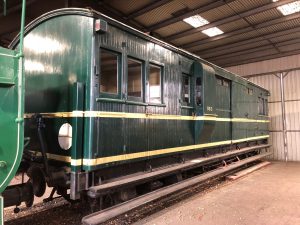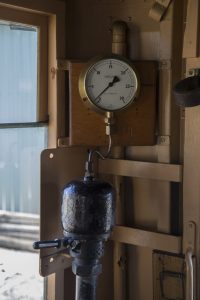AB1
AB1 is a 1st and 2nd class carriage with four compartments to seat 36 passengers. Built in England for the Launceston and Western Railway in 1869, it was fitted to a four-wheel underframe to suit the 1600mm track gauge (Broad Gauge). It was later fitted with a six-wheel underframe to suit the 1067 mm gauge in the 1886–1888 period, after the conversion of broad gauge line to narrow gauge. AB1 was relegated to secondary services in early 1900s, and was retired from passenger service in 1953 and converted to workers camp car. AB1 was donated by the Tasmanian Government Railways (TGR) in 1972 to the museum.



B+4 and B+21
Both B+ carriages are end platform first or second-class saloon carriages built for the Tasmanian Main Line Railway Company (TMLR) in about 1885. Both are fitted with six-wheel underframes. Following the takeover of the TMLR by the Tasmanian Government Railways (TGR) in 1890, the carriage bodies were widened and they were then used as second class cars. By the 1920s they were relegated to Hobart suburban train services. Both carriages were out of service by 1950 and B+4 was converted to a camp car. Both carriages were sold to the museum in 1971–1972. B+21 is fully restored whilst B+4 is currently being converted into a Birthday Party carriage.





A+17
A+17 is an end platform first-class saloon carriage built for the Tasmanian Main Line Railway (TMLR).
Following takeover of the Tasmanian Main Line Railway Company (TMLR) by the Tasmanian Government Railways (TGR) the carriage was one of a number transferred to the Bellerive to Sorell railway, which opened in May 1892. Following the closure of the railway in June 1926 the body was sold for private use and was later donated to the museum by Mr B Johnston in 1979. The body was mounted on a four-wheel underframe purchased from Australian National Railways (ANR).


AAL10
AAL10 is Tasmanian Government Railways (TGR) first class double-bogie saloon carriage built in the Launceston Workshops in 1930. AAL10 was used on main line passenger services from its introduction into service. It also operated on secondary and suburban passenger services from the 1950s until regular suburban passenger services were withdrawn at the end of 1974. AAL10 was purchased from Australian National Railways (ANR) in 1979.

DB3
DB3 is a Tasmanian Government Railways (TGR) double-bogie guards van that includes a guard’s compartment, a freight/luggage storage compartment, dog travelling compartment and two passenger compartments for 16 passengers. Built in 1885, DB3 was one of a large class of standard TGR guards vans that were found on trains throughout the TGR system. The original body was replaced by a new body in 1947, the newer body being of a similar design but with numerous detail differences. DB3 was withdrawn from service in 1986 at a time when guards vans were dispensed with on trains. DB3 was donated by AN Tasrail.


SP4
In August and September 1931 two single-engine steam railcars, SP1 and SP2, were introduced to service. Despite being steam rather than petrol or diesel powered, these cars ran well and were capable of maintaining fast times on main line. The steam railcars had the disadvantage of requiring more servicing and required a fireman as part of the crew, which the petrol or diesel powered cars did not require, but in spite of this another two cars, SP3 and SP4, were introduced in 1934. Five more similar cars were introduced in 1937 with oil fired boilers.
SP3 to SP9 differed from the first two steam railcars in that they had larger boilers and two engines fitted, one to drive an axle at each end of the car. The extra power of these cars enabled them to haul one or two carriages to gain extra passenger capacity when required. With the introduction of more DP Railcars, SP4 had it boiler removed in 1950 and was used as a passenger carriage. SP4 was delivered to the museum on 19 October 1979. The prolonged restoration of SP4 was finally completed in early 1999, it has being refurbished to a 1950s colour scheme that complements AAL10.


SS7
The carriage is one of nine SS class double bogie suburban saloon carriages built by the Tasmanian Government Railway’s Launceston workshops, chiefly for the Hobart suburban services. Their all-steel bodies had the same width and profile as the Tasman Limited carriages and the 1951 to 1954-built EEP class express vans. The design was a repeat of a carriage that the TGR built for the Emu Bay Railway in early 1954.
Although having new bodies, their underframes were re-used from scrapped wooden side-door carriages; in the case of SS7 the underframe is from the clerestory roofed carriage ABL4 which was built in Launceston in 1903. The SS cars entered service between November 1956 and April
1964, with a further two cars being built in late 1964 but modified by including guards facilities; these were classified SSD. SS7 entered service on 10 May 1963.
The SS/SSD carriages were painted in the TGR red and cream colour scheme throughout their working lives. Although a familiar sight running as a set on suburban trains, single cars were often used for extra seating on the Tasman Limited, particularly between Wynyard and Devonport. They also made appearances on excursion and show trains which continued after the suburban services ceased at the end of 1974. All were written off in October 1978 and were subsequently sold. Four sister cars are part of the Margate Train and the other four went to West Australia.
The car acquired by Don River Railway and formed part of their mainline carriage set. It was stored sometime between 2005 and 2020 due to a leaking roof and has now been leased to the Tasmanian Transport Museum on a long term lease agreement. The carriage will be restored to running order for use on passenger trains. SS7 arrived at the museum in February 2025.




